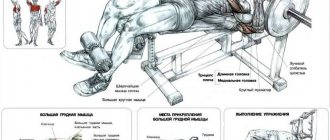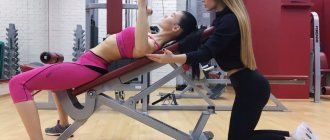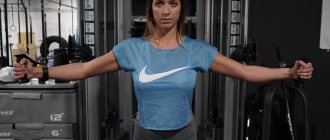So, how are these workouts different? Split involves working different muscle groups on different days. For example: Monday - legs + back, Wednesday - chest + shoulders, Friday - legs + abs. Fullbody uses all muscle groups in one session. That is, on Monday, Wednesday, and Friday - legs + back + chest + shoulders + abs. Both types of training involve the use of relatively heavy weights, low repetitions and long rests between sets.
Fullbody is often confused with circuit training or even used interchangeably. Indeed, in a circular workout, all muscle groups are also worked out in 1 workout. But it is done in a completely different mode: relatively light weights, many repetitions, short rest between approaches. It is closer to strength aerobics, aimed at developing endurance and burning fat, while fullbody and split are purely strength training for building muscles and reducing subcutaneous fat.
A little history
In my articles I often plunge into the past, and this time will not be an exception. So, in the early days of bodybuilding, the dominant training approach was one that advocated training the entire body in a training session. This training approach was called full - body training . Athletes simply trained each muscle group in their body, performing one basic exercise for each of them. At the next training session, it was possible to replace the exercises with similar ones and change the order of their execution.
With increasing training experience, athletes noticed that increasing the volume of loads and working the entire body for each workout became too tiring. They began to divide their body into conditional zones and work on them on separate days. This is how the split approach was born - separate training .
According to another theory, the emergence of split training was significantly influenced by the beginning of the use of various pharmacological drugs in sports.
Fulbadi
This is a full body workout. That is, in one workout you work out almost all muscle groups.
The benefits of working in this mode are the maximum amount of calories burned, which is very appropriate for those who want to lose weight. Fulbadi is often done in a circular mode, when rest is allowed only after the next round of exercises (there can be from five to eight).
In addition, this option is suitable for a beginner to “get into” the mode.
Training principles
As a rule, in this training approach, the athlete performs only one basic exercise per muscle group in 2-3 approaches. In total you get about 6-8 exercises for the whole body. Why so few? The fact is that training, even with this option, will take at least an hour, or even more. Imagine how long such a workout will last if you perform more than one basic exercise for each muscle group? What if we increase the number of approaches? Surely after such a workout you will be completely exhausted, and your nervous system will rebel.
To prevent this from happening, you need to approach this type of training wisely. You either train hard once every 4-5 days , or train more often, but with different levels of intensity . The classic full body workout is the “heavy-light-medium” pattern. This means that you will have three workouts of varying intensity per week. The first workout is the hardest, the second, a day later, will be easy. Every other day there should be a moderate intensity workout, followed by two days of rest.
A more advanced full body training scheme involves an emphasis on some kind of movement in “your day” . For example, Monday is heavy squat day. On this day, the athlete performs 3-4 sets of back squats with heavy weights and close to failure, but he trains the rest of the body with light effort. On Wednesday, the athlete performs a heavy bench press and again works the rest of the body lightly or moderately. Friday is heavy deadlift day.
Monday:
| Exercise name | Approaches | Replays | Rest, min | Intensity level |
| Squats | 4 | 6-8 | 3-5 | hard |
| Lying leg curls | 2 | 15 | 2 | easily |
| Dips | 2 | 12-15 | 2 | easily |
| Bent-over barbell row | 3 | 10 | 2-3 | average |
| Standing flyes | 3 | 12 | 2 | easily |
| Barbell curl | 3 | 10 | 2 | average |
| Hyperextension | 3 | 15 | 2 | average |
Wednesday:
| Exercise name | Approaches | Replays | Rest, min | Intensity level |
| Bench press | 4 | 6-8 | 3-5 | hard |
| Upper block pull | 3 | 12 | 2 | easily |
| Standing barbell press | 3 | 8 | 2 | average |
| Leg press | 3 | 15 | 2 | easily |
| Standing calf raise | 4 | 10 | 2 | hard |
| Crunches | 4 | 15 | 2 | average |
Friday:
| Exercise name | Approaches | Replays | Rest, min | Intensity level |
| Deadlift | 4 | 6-8 | 3-5 | hard |
| Inclined dumbbell press | 2 | 15 | 2 | easily |
| Pull-ups | 3 | 10 | 2 | average |
| Tilt wiring | 3 | 12 | 2 | easily |
| Arm extensions in block | 3 | 12 | 2 | easily |
| Seated leg extensions | 3 | 15 | 2 | easily |
I repeat - changing the load is necessary! Moderate to light loads mean you should stop well before failure. A heavy load means you lift the weight to the point of extreme fatigue , near failure , or failure.
Level: advanced athletes
For experienced athletes, the scientific evidence is very contradictory. For example, American scientists [3], studying experienced athletes (on the example of a sample also consisting of 20 people), who were divided into two groups (the first group trained in a three-day split, the second in a three-day fullbody), came to a diametrically opposite conclusion than Japanese scientists: fullbody training has an advantage in hypertrophy over split training, but for strength indicators there is no difference in how to train. It is concluded that the more often muscles receive a training stimulus, the greater their hypertrophy.
However, other experiments do not support this conclusion. Recently, researchers from Brazil [4] showed that a split program, which involves loading a muscle group once a week, is a more optimal training scheme for experienced athletes than a fullbody. This statement appeared after the following experiment: they divided 23 athletes with at least 5 years of training experience into two groups and observed them for 8 weeks. Both groups trained 5 times a week with working weights of 70-80% of 1RM. At the same time, the first group worked out on a 5-day split, the second - on a 5-day fullbody, pumping each muscle group 5 times a week (from Monday to Friday). The weekly volume of work performed in both groups was the same (each muscle group received 10 sets per week). The following exercises were used: bench press, squats, leg press in the simulator, leg curls in the hamstring machine, standing biceps lift, triceps pull-down, sitting pull-down, standing dumbbell flyes, calf raises (for calf exercises), abdominal exercise and hyperextension.
Briefly about the results: both groups progressed approximately equally in strength and muscle hypertrophy, that is, the second group did not demonstrate an advantage in mass, as was shown in the experiment of American scientists. This experience, on the one hand, indicates that the effectiveness of training with weights largely depends on the selected training parameters (volume, intensity, etc.). But on the other hand, it casts doubt on the idea that the more often we give the muscles a training stimulus, that is, the more often we increase the synthesis of muscle proteins, the more noticeable the hypertrophy. This experiment is further proof that there is no direct relationship between muscle growth and stimulation of protein synthesis in them (increased anabolism). Meanwhile, it is worth paying attention to the fact that loading the same muscles for 5 days in a row, as shown in the experiment, does not carry anything critical with an adequate amount of work. Although this does not make sense from the standpoint of optimal training (why do it 5 times a week if the result will be the same as with one), it is a field for thinking about the regenerative abilities of our body.
Split Training Principles
Split involves the athlete dividing his body into muscle groups and training them on certain days. With this option, you can increase the training volume - perform 2-3 exercises for each muscle group . Each muscle group is usually trained only once a week, but there is a caveat here. The fact is that even in a split, one way or another, all muscle groups are affected. For example, when performing a deadlift, the back extensors, buttocks and leg muscles are worked. Squats work the legs themselves, as well as the glutes and back extensors. But most of the load in the split falls on the arms, especially the triceps and anterior deltoids.
Split can be organized in different ways. If you divide the body into top and bottom, then this will also be considered a split, although not the kind that we are used to seeing. With this option, you can alternate the top and bottom, training every other day.
Another split option is more common among trainees - this is the classic 3 workouts per week, when each of them works one large and one or two small muscle groups. Split training can be organized in the following way.
Monday:
| Exercise name | Approaches | Replays | Rest, min |
| Bench press | 3 | 8 | 3 |
| Incline Dumbbell Press | 3 | 10 | 2 |
| Lying flyes | 3 | 15 | 1 |
| Barbell curl | 3 | 10 | 2 |
| Seated dumbbell raises with supination | 3 | 10 | 2 |
| Crunches | 4 | 15 | 1 |
Wednesday:
| Exercise name | Approaches | Replays | Rest, min |
| Deadlift | 3 | 6-8 | 3-5 |
| Pull-ups | 3 | Max. | 2-3 |
| Lower block thrust | 3 | 10 | 2 |
| Bent-over dumbbell flyes | 3 | 10-12 | 2 |
| Close grip barbell press | 3 | 10 | 2 |
| Arm extensions in block | 3 | 10-15 | 2 |
| Oblique crunches | 4 | 15 | 1 |
Friday:
| Exercise name | Approaches | Replays | Rest, min |
| Back Squats | 3 | 8-10 | 3-5 |
| Leg press | 3 | 12 | 2 |
| Lying leg curls | 3 | 10-15 | 2 |
| Standing calf raises | 4 | 10-12 | 2 |
| Seated barbell press | 3 | 8 | 2 |
| Standing dumbbell flyes | 3 | 12-15 | 2 |
| Hanging Leg Raises | 3 | Max. | 2 |
As you can see, the volume of the training load has increased significantly compared to full body training. There was also additional stress on the arms and deltoids.
Advantages of fullbody and split circuits in strength training
An absolute plus of fullbody training: it’s easy to create a lesson plan yourself. The classic version - first, large muscle groups are worked out (legs, back, chest), and then smaller ones (shoulders, arms). “The proposed option is the simplest and optimal,” agrees Alexander Mironenko. — At the beginning of training, while you still have a lot of strength, you should train the largest muscles, perform difficult-to-coordinate, basic exercises, since they require more concentration and take a lot of strength. Then, as you get tired, you move on to performing psychologically and physically less difficult exercises, switching to small muscle groups and performing isolation exercises. A training structured in this way will give maximum effect.”
Of course, you can work the muscles in a different order. But it’s safest to work on your own with the one we gave above, since it’s better to perform complex exercises against a background of fatigue under the supervision of a trainer.
It is more difficult to create a split scheme. The main problem for a beginner is how to distribute exercises for different muscle groups by day of the week. There are many options here too. As a rule, they combine “heavy” days (training two large muscle groups), “light” (3-4 small muscle groups), and “combined” (1 large + 1-2 small groups).
“Split training is the most optimal, balanced and effective scheme for planning the training process,” Alexander Mironenko is sure. “You will have more opportunity and time to work on problem areas, which means split training allows you to shape your figure more effectively.” Indeed, problem areas can be worked out on different days, either with complex basic exercises or with easier isolated exercises. For example, the “breeches” zone is worked out both in squats and lunges, as well as in isolated exercises (legs adjoining and spreading).
What's better?
This question is natural after reading this article, and I will try to answer it. The fact is that different approaches to training are suitable for different periods of time. Full body training is great for beginners and during the recovery period, as well as when you return to strength training after a long break. However, sooner or later your muscles will get used to the small volume of load, and it will need to be increased. Of course, if you want to progress further. Surprisingly, some athletes progress perfectly throughout their entire lives with full body training, without resorting to splits.
However, most people still sooner or later switch to a split system. Unfortunately, many switch to split too early , literally from the first classes in the gym. I believe that this is not entirely correct, since full body training allows beginners to gain weight and strength in the shortest possible time. On a split, this process is somewhat extended. But we want to achieve bigger muscles faster, don’t we? Therefore, I recommend training according to the full body scheme for at least six months, and then switching to split. A compromise is also possible - this is the division of the body into top and bottom. We can say that this is something between a full body and a split.
Whatever you choose, remember - no training regimen will give good results without proper nutrition and proper rest . If you want to gain weight faster, I recommend taking a gainer and creatine. If you want to effectively lose weight, then I would advise you to choose full body training and, in particular, one of its modifications - circuit training. In this case, it will not be superfluous to take beta-alanine and carnitine. I wish everyone anabolism!











